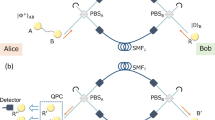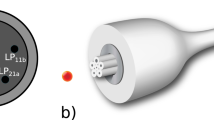Abstract
The transfer of quantum information through a noisy environment is a central challenge in the fields of quantum communication, imaging and nanophotonics. In particular, high-dimensional quantum states of light enable quantum networks with significantly higher information capacities and noise robustness as compared with qubits. However, although qubit entanglement has been distributed over large distances through free space and fibre, the transport of high-dimensional entanglement is hindered by the complexity of the channel, which encompasses effects such as free-space turbulence or mode mixing in multimode waveguides. Here, we demonstrate the transport of six-dimensional spatial-mode entanglement through a 2-m-long, commercial multimode fibre with 84.4% fidelity. We show how the entanglement can itself be used to measure the transmission matrix of the complex medium, allowing the recovery of quantum correlations that were initially lost. Using a unique property of entangled states, the medium is rendered transparent to entanglement by carefully ‘scrambling’ the photon that did not enter it, rather than unscrambling the photon that did. Our work overcomes a primary challenge in the fields of quantum communication and imaging, and opens a new pathway towards the control of complex scattering processes in the quantum regime.
This is a preview of subscription content, access via your institution
Access options
Access Nature and 54 other Nature Portfolio journals
Get Nature+, our best-value online-access subscription
$29.99 / 30 days
cancel any time
Subscribe to this journal
Receive 12 print issues and online access
$209.00 per year
only $17.42 per issue
Buy this article
- Purchase on Springer Link
- Instant access to full article PDF
Prices may be subject to local taxes which are calculated during checkout




Similar content being viewed by others
Data availability
Data that support the plots within this paper and other findings of this study are available from the corresponding authors upon reasonable request. Source data are provided with this paper.
References
Rotter, S. & Gigan, S. Light fields in complex media: mesoscopic scattering meets wave control. Rev. Mod. Phys. 89, 015005 (2017).
Papadopoulos, I. N., Farahi, S., Moser, C. & Psaltis, D. High-resolution, lensless endoscope based on digital scanning through a multimode optical fiber. Biomed. Opt. Exp. 4, 260–270 (2013).
Plöschner, M., Tyc, T. & Čižmár, T. Seeing through chaos in multimode fibres. Nat. Photon. 9, 529–535 (2015).
Turtaev, S. et al. High-fidelity multimode fibre-based endoscopy for deep brain in vivo imaging. Light Sci. Appl. 7, 92 (2018).
Popoff, S. M. et al. Measuring the transmission matrix in optics: an approach to the study and control of light propagation in disordered media. Phys. Rev. Lett. 104, 100601 (2010).
Leedumrongwatthanakun, S. et al. Programmable linear quantum networks with a multimode fibre. Nat. Photon. 14, 139–142 (2020).
Defienne, H., Barbieri, M., Walmsley, I. A., Smith, B. J. & Gigan, S. Two-photon quantum walk in a multimode fiber. Sci. Adv. 2, e1501054 (2016).
Wolterink, T. A. W. et al. Programmable two-photon quantum interference in 103 channels in opaque scattering media. Phys. Rev. A 93, 53817 (2016).
Defienne, H., Reichert, M. & Fleischer, J. W. Adaptive quantum optics with spatially entangled photon pairs. Phys. Rev. Lett. 121, 233601 (2018).
Gisin, N. & Thew, R. Quantum communication. Nat. Photon. 1, 165–171 (2007).
Kelly, J. et al. State preservation by repetitive error detection in a superconducting quantum circuit. Nature 519, 66–69 (2015).
Acin, A. et al. Device-independent security of quantum cryptography against collective attacks. Phys. Rev. Lett. 98, 230501 (2007).
Krenn, M., Malik, M., Erhard, M. & Zeillinger, A. Orbital angular momentum of photons and the entanglement of Laguerre–Gaussian modes. Philos. Trans. R. Soc. A 375, 20150442 (2017).
Bavaresco, J. et al. Measurements in two bases are sufficient for certifying high-dimensional entanglement. Nat. Phys. 14, 1032–1037 (2017).
Erhard, M., Malik, M., Krenn, M. & Zeilinger, A. Experimental Greenberger–Horne–Zeilinger entanglement beyond qubits. Nat. Photon. 12, 759–764 (2018).
Schneeloch, J., Tison, C. C., Fanto, M. L., Alsing, P. M. & Howland, G. A. Quantifying entanglement in a 68-billion-dimensional quantum state space. Nat. Commun. 10, 2785 (2019).
Mirhosseini, M. et al. High-dimensional quantum cryptography with twisted light. N. J. Phys. 17, 33033 (2015).
Islam, N. T., Lim, C. C. W., Cahall, C., Kim, J. & Gauthier, D. J. Provably secure and high-rate quantum key distribution with time-bin qudits. Sci. Adv. 3, e1701491 (2017).
Ecker, S. et al. Overcoming noise in entanglement distribution. Phys. Rev. X 9, 041042 (2019).
Zhu, F., Tyler, M., Valencia, N. H., Malik, M. & Leach, J. Are high-dimensional entangled states robust to noise? Preprint at https://arxiv.org/pdf/1908.08943v1.pdf (2019).
Brida, G., Genovese, M. & Berchera, I. R. Experimental realization of sub-shot-noise quantum imaging. Nat. Photon. 4, 227–230 (2010).
Lemos, G. B. et al. Quantum imaging with undetected photons. Nature 512, 409–412 (2014).
Vertesi, T., Pironio, S. & Brunner, N. Closing the detection loophole in Bell experiments using qudits. Phys. Rev. Lett. 104, 60401 (2010).
Bavaresco, J. et al. Most incompatible measurements for robust steering tests. Phys. Rev. A 96, 22110 (2017).
Yin, J. et al. Satellite-based entanglement distribution over 1,200 kilometers. Science 356, 1140–1144 (2017).
Inagaki, T., Matsuda, N., Tadanaga, O., Asobe, M. & Takesue, H. Entanglement distribution over 300 km of fiber. Opt. Exp. 21, 23241–23249 (2013).
Cao, H. et al. Distribution of high-dimensional orbital angular momentum entanglement over a 1-km few-mode fiber. Optica 7, 232–237 (2020).
Jamiołkowski, A. Linear transformations which preserve trace and positive semidefiniteness of operators. Rep. Math. Phys. 3, 275–278 (1972).
D’Ariano, G. M. & Lo Presti, P. Quantum tomography for measuring experimentally the matrix elements of an arbitrary quantum operation. Phys. Rev. Lett. 86, 4195–4198 (2001).
Konrad, T. et al. Evolution equation for quantum entanglement. Nat. Phys. 4, 99–102 (2007).
Altepeter, J. B. et al. Ancilla-assisted quantum process tomography. Phys. Rev. Lett. 90, 193601 (2003).
Ndagano, B. et al. Characterizing quantum channels with non-separable states of classical light. Nat. Phys. 13, 397–402 (2017).
Carpenter, J., Eggleton, B. J. & Schröder, J. Observation of Eisenbud–Wigner–Smith states as principal modes in multimode fibre. Nat. Photon. 9, 751–757 (2015).
Popoff, S., Lerosey, G., Fink, M., Boccara, A. C. & Gigan, S. Image transmission through an opaque material. Nat. Commun. 1, 81 (2010).
Klyshko, D. N. A simple method of preparing pure states of an optical field, of implementing the Einstein–Podolsky–Rosen experiment, and of demonstrating the complementarity principle. Sov. Phys. Usp. 31, 74–85 (1988).
Peeters, W. H., Moerman, J. J. D. & van Exter, M. P. Observation of two-photon speckle patterns. Phys. Rev. Lett. 104, 173601 (2010).
Franson, J. D. Nonlocal cancellation of dispersion. Phys. Rev. A 45, 3126–3132 (1992).
Black, A. N. et al. Quantum nonlocal aberration cancellation. Phys. Rev. Lett. 123, 143603 (2019).
Wootters, W. & Fields, B. Optimal state-determination by mutually unbiased measurements. Ann. Phys. 191, 363–381 (1989).
Friis, N., Vitagliano, G., Malik, M. & Huber, M. Entanglement certification from theory to experiment. Nat. Rev. Phys. 1, 72–87 (2019).
Malik, M. et al. Multi-photon entanglement in high dimensions. Nat. Photon. 10, 248–252 (2016).
Valencia, N. H. et al. High-dimensional pixel entanglement: efficient generation and certification. Preprint at https://arxiv.org/pdf/2004.04994.pdf (2020).
Bouchard, F. et al. Measuring azimuthal and radial modes of photons. Opt. Exp. 26, 31925–31941 (2018).
Fontaine, N. K. et al. Laguerre–Gaussian mode sorter. Nat. Commun. 10, 1865 (2019).
Wollman, E. E. et al. Kilopixel array of superconducting nanowire single-photon detectors. Opt. Exp. 27, 35279–35289 (2019).
Mounaix, M. et al. Spatiotemporal coherent control of light through a multiple scattering medium with the multispectral transmission matrix. Phys. Rev. Lett. 116, 253901 (2016).
Epping, M., Kampermann, H., Macchiavello, C. & Bruß, D. Multi-partite entanglement can speed up quantum key distribution in networks. New J. Phys. 19, 093012 (2017).
Kang, S. et al. Imaging deep within a scattering medium using collective accumulation of single-scattered waves. Nat. Photon. 9, 253–258 (2015).
Diamanti, E., Lo, H.-K., Qi, B. & Yuan, Z. Practical challenges in quantum key distribution. npj Quantum Inf. 2, 16025 (2016).
Moreau, P.-A., Toninelli, E., Gregory, T. & Padgett, M. J. Imaging with quantum states of light. Nat. Rev. Phys. 1, 367–380 (2019).
Acknowledgements
We thank M. Huber, N. Friis, D. Phillips, S. Leedumrongwatthanakun and A. Fedrizzi for helpful discussions. This work was made possible by financial support from the QuantERA ERA-NET Co-fund (FWF Project I3773-N36) and the UK Engineering and Physical Sciences Research Council (EP/P024114/1). H.D. acknowledges funding from the European Union’s Horizon 2020 research and innovation programme under the Marie Skłodowska-Curie grant agreement no. 840958.
Author information
Authors and Affiliations
Contributions
M.M. conceived the research and supervised the project. M.M. and H.D. designed the experiment. N.H.V. and S.G. performed the experiment. All authors developed theoretical methods, analysed the data and contributed to writing the manuscript.
Corresponding authors
Ethics declarations
Competing interests
The authors declare no competing interests.
Additional information
Publisher’s note Springer Nature remains neutral with regard to jurisdictional claims in published maps and institutional affiliations.
Extended data
Extended Data Fig. 1 ‘Scrambled’ correlations of the output state \(\left|{\psi }_{\text{MMF}}\right\rangle\).
Two-photon coincidence counts in the 7-dimensional Pixel basis \({\{\left|m\right\rangle ,\left|n\right\rangle \}}_{m,n}\), and its 7 mutually unbiased bases \({\{\left|{f}_{m}\right\rangle ,\left|{f}_{n}\right\rangle \}}_{m,n}\) at the output of the multimode fibre. For this set of measurements we obtained a fidelity to the maximally entangled state of \(\tilde{F}(\rho_T ,{\psi }^{+})=5.4\pm 1.0 \%\), that is, no entanglement can be certified.
Extended Data Fig. 2 S matrix measurement.
Examples of computer-generated holograms displayed on the SLMs corresponding to (a) Alice and (b) Bob, when measuring a given matrix element \({R}_{mn}^{\theta }\). Changing the relative phase θ, we obtain matrices Rθ that allow us to calculate the elements Smn through Eq. (17). The absolute value of the matrix S is shown in (c).
Extended Data Fig. 3 E matrix measurement.
Examples of computer-generated holograms displayed on the SLMs corresponding to (a) Alice and (b) Bob, when measuring matrix elements \({R}_{m}^{\theta }\). We change the relative phase θ via a phase-stepping process to determine the diagonal elements (m = n) of the matrix E. The absolute value of this diagonal matrix is shown in (c).
Supplementary information
Supplementary Information
Supplementary discussion and methods, Figs. 1–6, equations (1)–(23) and Tables 1 and 2.
Source data
Source Data Fig. 2
Transmission matrix.
Source Data Fig. 3
Correlations measured in two bases in the absence and presence of the MMF.
Source Data Fig. 4
Recovered correlations in the Pixel and seven ‘tilted’ Pixel bases.
Source Data Extended Data Fig. 1
Scrambled correlations in eight mutually unbiased bases in the presence of the MMF.
Source Data Extended Data Fig. 2
Absolute value of S matrix.
Source Data Extended Data Fig. 3
Absolute value of E matrix.
Rights and permissions
About this article
Cite this article
Valencia, N.H., Goel, S., McCutcheon, W. et al. Unscrambling entanglement through a complex medium. Nat. Phys. 16, 1112–1116 (2020). https://doi.org/10.1038/s41567-020-0970-1
Received:
Accepted:
Published:
Issue Date:
DOI: https://doi.org/10.1038/s41567-020-0970-1
This article is cited by
-
Inverse design of high-dimensional quantum optical circuits in a complex medium
Nature Physics (2024)
-
Efficient dispersion modeling in optical multimode fiber
Light: Science & Applications (2023)
-
Coherent backscattering of entangled photon pairs
Nature Physics (2023)
-
Frequency-insensitive spatiotemporal shaping of single photon in multiuser quantum network
npj Quantum Information (2023)
-
All-fiber source and sorter for multimode correlated photons
npj Quantum Information (2022)



